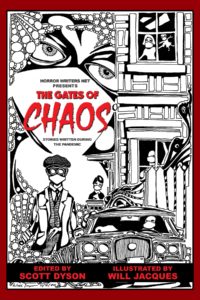(This is cross-posted from The Gates of Anthology blog)
So I’m going to start out by admitting that I don’t know what I’m talking about. I’m using the terms “linear” and “non-linear” in a specific way, to describe certain observations I make about stories I’ve read. I’m also using them to talk about my own writing, my successes and failures as a writer, and what I try to do to make it better.
“America’s Pastime,” my entry into the Gates of Chaos anthology, was very much a linear tale when it was written. I wrote it in the 1990’s for a contest that was called “The Publican Brief.” (The contest name was a mashup of a popular John Grisham novel and the name of the Delphi forum that I helped to run.) We were given six words and an opening sentence for this particular contest. Some of the contests only gave the six words. Some gave opening sentences. Some gave a topic. I recall that this one was both because I remember the opening sentence: “All things are found in the blood.”
I constructed a story around those words, and if you’ve read the anthology, you know the basic tale. All that mattered was what happened in the story. Nothing else. It was linear. It told the story of this ballplayer sliding into second base, getting spiked in the leg and having his calf ripped open, and passing out. When he comes around, he finds that he is surrounded by monsters. And he’s going to have to fight his way out. As he begins to be overwhelmed by the monsters, he again loses consciousness, and wakes up laying at second base with players and coaches looking down at him in a concerned manner. I used the six words and the opening sentence and constructed a story around them. (I recall that one of the words/phrases was “confederacy of the dead” and I think it’s still in the story.)
It’s hard to not be linear in a short story. You don’t have the word count to fill in the back story of your character/s. Still, I tried to add non-linear elements in the rewritten, anthology version of “America’s Pastime.” I gave my main character a bit of history. Now he’s a rookie, in camp during Covid, and he has to stay. Why does he have to stay in Arizona? That’s the bit of non-linear element that I was able to add. He can’t go home because he lives with his grandparents, and they’re elderly and susceptible to contracting a disease which was, at the time of the story (March of 2020), putting a lot of people in the hospital and on ventilators. So my character decides he’s better off staying in Arizona by himself.
And who wouldn’t want to stay in Arizona, anyway, in the spring? Have you ever been there? I have. It’s beautiful. The desert is beginning to bloom and it’s cool enough to enjoy the outdoors. And there’s tons of baseball!
Our anthology has examples of both types of storytelling. There is a lot of linear storytelling (A->B->C) but there are also neat little bits of non-linear elements in some of the stories. BT Noonan’s outstanding opening tale, “The Tunnel,” takes us back and forth in time in the mind of a veteran of the Vietnam conflict. I think it makes this story one of the finest in the entire anthology. Chris Stenson’s “Two Bobbies” has its roots going back into the main character’s past experiences to talk about the current horror he faces. Florence Ann Marlowe’s story “Dancing With The Dead” takes us into a horrific future by telling us what has come to pass in the recent past.
I recently read a book by Howard Odentz, called Bloody Bloody Apple, which uses non-linear storytelling brilliantly. In that work, Odentz takes us through the current horror his three main characters are living through by showing us the history of both the main characters and the town of Apple itself. It made me think about my own stories in much more depth. Where did I use this sort of effect in my novellas?
My story Odd Man Out does a nice job of weaving non-linear elements into the narrative (if I do say so myself). In that story, Roger Sinclair is plotting to off his “best friend” Paul Wagner, who he believes stole the love of his life. How did this come to pass? Read the story and find out! Here’s the link to it: ODD MAN OUT.
I reveal the reasons through Roger’s, Paul’s and Amy’s memories of the night in question. The slightly dark nature of the “Cabin Weekend” also comes into focus as we learn more about the main characters through the non-linear elements of the novella.
Do you, dear reader, have any thoughts about non-linear storytelliing versus linear storytelling? If so, please feel free to leave a comment!

